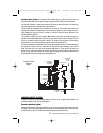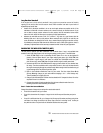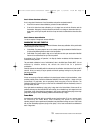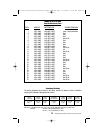
13
Edelbrock Performer Series Carburetor Owner’s Manual 8/94
Case 2: Slower than base calibration
Go to 1 stage lean Primaries and 1 lean Secondaries and perform acceleration test #3.
• If test #3 is the same as base calibration, go back to the base calibration.
• If test #3 is faster than base calibration, go to 2 stages lean on both the Primaries and the
Secondaries. Keep going in the lean direction until there is no change or slower then back up 1
stage richer, so that you stay with the richer of any two levels of calibration that have the same
power.
Case 3: Same as base calibration
Do not be surprised. Change back to base calibration.
CALIBRATING THE PART-THROTTLE
The Metering Rod feature used in the Edelbrock Performer allows easy calibration of the part-throttle
without change to the WOT metering.
• Cruise Mode: The power output is low, as in a steady cruise light acceleration. Manifold Vacuum
is high and the Metering Rods are down in the lean position.
• Power Mode: The power output is high, as in a heavy but not wide-open acceleration. Manifold
Vacuum is low and the Rods are up in the rich position.
As explained in the “Theory of Operation,” the Step-Up function modulates the Rods between the
Cruise and Power positions.
The part-throttle calibration is more “individualized” than is the Wide-Open-Throttle (WOT). It is not
measured by absolute numbers, but reflects the driver’s feel for a particular
combination.
Carefully evaluate the driveability with the carburetor at the calibration level determined from the WOT
exercise. Drive at a variety of engine speeds and throttle openings looking for any flat spots or
lean/surge conditions.
Cruise Mode
If there are any surge or flat spot conditions in the steady speed cruises or light accelerations, a lean
condition probably exists. Consult the Calibration Reference Chart and change to 1 stage rich in the
Cruise Mode. If it gets better, but not completely fixed, keep going in the rich direction. The
Calibration Reference Chart will give you Rod and Jet combinations that are directionally correct or
you may choose your own.
If the light throttle is satisfactory, trying going 1 stage lean in the Cruise Mode. If there are still no
problems with surge or other indications of lean metering, do not hesitate to go to 2 stages lean in the
Cruise Mode. A lean Cruise Mode has advantages in fuel economy and keeping the plugs clean. Keep
going until you begin to notice driveability problems and then back up 1 stage.
Power Mode
Accelerations at part-throttle with low manifold vacuum (less than about 5” Hg on a vacuum gauge)
are metered by the Power Mode. Avoid calibrating this portion of the engine’s
operating range too lean as spark knock (detonation) and piston/valve burning can occur. If this mode
has any lean driveability symptoms (surge or flat spots), it is too lean and should be recalibrated at
least 1 stage richer.
1403-1413 Perf Series Carburetor Owner's Manual.qxd 3/31/2006 12:04 PM Page 13


















